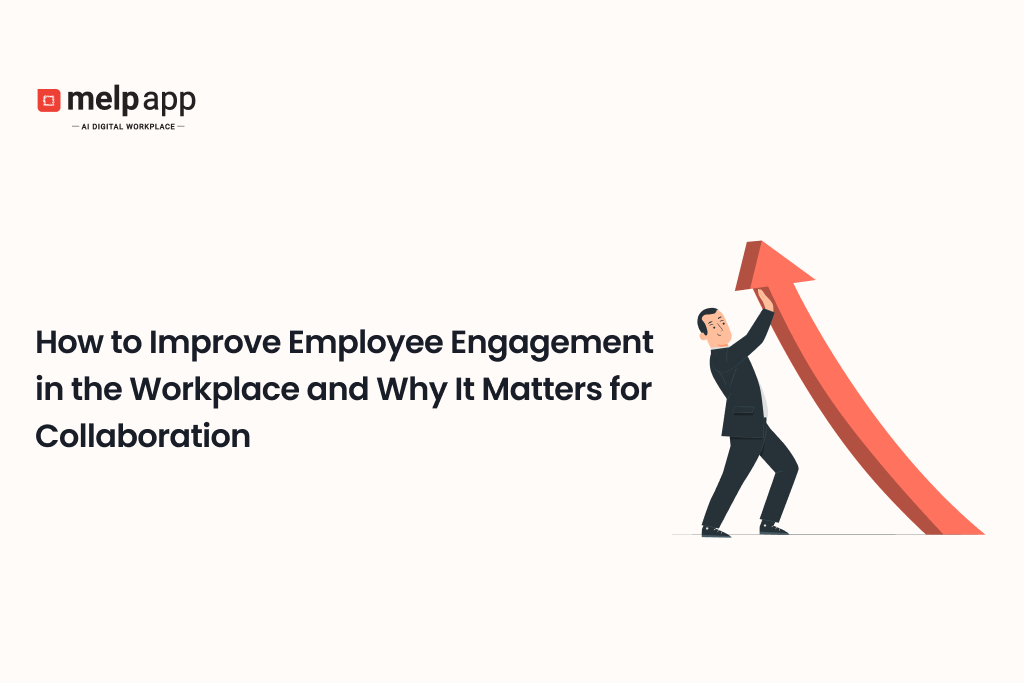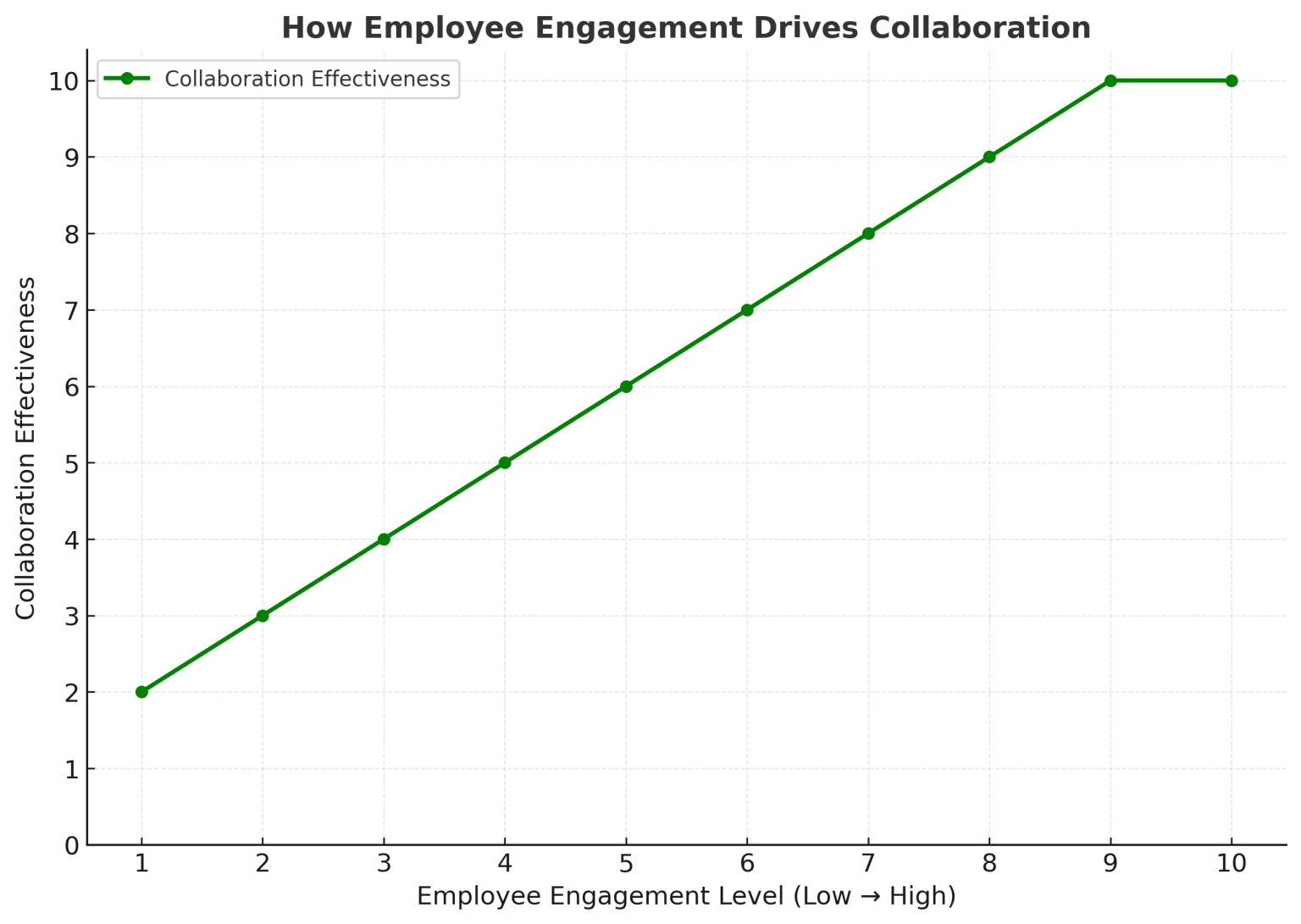
Employee engagement isn’t just about job satisfaction. It’s about building a culture where people feel involved, valued, and motivated to contribute. When employees are engaged, they’re not just doing their jobs—they’re showing up with purpose, supporting their teammates, and helping the whole organization move forward. That kind of energy directly supports better collaboration, which leads to faster progress, smarter ideas, and stronger results.
Let’s break down how engagement works, how it affects collaboration, and what you can do to make a real impact.
What Is Employee Engagement?
Employee engagement is the level of connection and commitment a person feels toward their work and workplace. It goes beyond doing the bare minimum. Engaged employees are emotionally invested in what they do. They care about their performance and want the company to succeed. This isn’t about perks or parties. It’s about meaning, purpose, recognition, and having the tools to do great work.
When people are engaged, they take more ownership, solve problems faster, and support their teammates without being asked. It’s about creating a space where people actually want to work, not just need to.
Why Engagement Fuels Real Collaboration
People work better together when they feel genuinely connected to what they’re doing. When a team feels distant or disengaged, things start to slip. Messages get overlooked, ideas lose momentum, and even helpful feedback can be misinterpreted.
But when folks are engaged, the dynamic shifts. They:
- Talk openly, because they feel safe with each other
- Share thoughts without worrying they’ll be ignored
- Jump in and take the lead when something needs doing
- Back each other up instead of just focusing on their tasks
You can’t fake that with software or a system. Collaboration doesn’t just happen because you tell people to do it—it shows up when people care about their work and the people around them. Engagement is what makes that possible.
Real Ways to Improve Employee Engagement (and Support Collaboration)
1. Give People a Voice
If people don’t feel heard, they check out. Ask for feedback, listen carefully, and use it. When employees see changes based on what they’ve said, they feel like their voice matters. Involve them in decisions that affect their daily work—it makes a difference.
Example: A mid-sized tech company held monthly “voice-of-the-team” sessions where employees could suggest improvements. One idea led to cutting down unnecessary reporting tasks. As a result, the team saved five hours a week and felt more respected.
How it helps collaboration: People feel safe sharing ideas and feedback, which makes team problem-solving easier.
2. Set Clear Goals (and Show Progress)
Everyone wants to know what success looks like. When goals are clear and meaningful, people understand why their work matters. Don’t just set targets and walk away—show how the team’s efforts connect to the bigger picture. Regular updates help everyone stay aligned.
Example: A sales manager started using a shared dashboard to track weekly goals. During Friday check-ins, she walked through what was achieved and what needed attention. It kept the team focused and motivated.
How it helps collaboration: Aligned goals reduce confusion and make it easier for teams to work toward the same outcome.
3. Recognize Real Contributions
People don’t need constant praise, but they do need to know their effort matters. Recognition doesn’t have to be formal. A sincere thank-you or a quick mention in a meeting can go a long way. When recognition feels real, it builds trust.
Example: A warehouse supervisor kept a whiteboard listing daily “shout-outs.” When someone stayed late or solved a tough issue, it went up on the board. Team morale noticeably improved.
How it helps collaboration: When people feel appreciated, they’re more likely to support others and go the extra mile.
4. Build Relationships, Not Just Roles
People work better together when they know each other. Make time for conversations that go beyond deadlines. A little effort toward human connection creates stronger team dynamics. Digital workplace software that supports informal chats or cross-functional spaces can help people connect outside of task-related work.
Example: A design team began starting Monday meetings with a light “what’s something good from your weekend?” check-in. It helped new team members feel welcome and broke the ice for better creative discussions.
How it helps collaboration: Strong relationships create trust, which improves how people communicate and work together.
5. Cut the Noise, Respect Focus
Too many meetings or constant messages make it hard to concentrate. Respect your team’s time. Give them the space to focus on what matters. When people feel their time is being used well, they stay more engaged.
Example: A remote support team implemented “quiet hours” each morning—no internal meetings or pings. Support tickets were resolved faster, and team stress went down.
How it helps collaboration: Teams work better together when everyone has the mental space to think clearly and respond meaningfully.
6. Support Growth, Not Just Output
People want to feel like they’re moving forward, not just checking boxes. Offer chances to learn something new, whether through mentoring, small project shifts, or upskilling. Growth creates energy.
Example: A customer service rep who shadowed the marketing team for a week gained new appreciation for the company’s messaging. Later, they helped create a better customer-facing script based on what they learned.
How it helps collaboration: People who are growing are more curious, more flexible, and more open to new ideas.
7. Lead by Example
If you want people to show up fully, you have to go first. Leaders set the tone. Be consistent, present, and honest. When leaders demonstrate genuine engagement, it encourages others to do the same.
Example: A team lead regularly shared her challenges during check-ins, including what she was working on and where she needed help. It created space for others to open up and support one another.
How it helps collaboration: Leadership sets the tone. If you show up fully, others are more likely to engage and contribute meaningfully.
How Employee Engagement Improves Collaboration in Real Workplace Settings
At a mid-sized consulting firm in Chicago, the operations team was off track. Meetings felt like boxes to check. Ideas weren’t moving. Progress was slow. No one was slacking, really—it just felt like people weren’t clicking.
Things started to shift when the department head stopped asking about deadlines and started asking what was getting in the way. Not just project stuff—she wanted to understand how people were working together, or not. Then she made a few small changes. Meetings had rotating leads. Project roles were clearer. She started checking in casually, not just in official 1-on-1s.
By the end of the month, the vibe had changed. People weren’t waiting for meetings—they were updating each other directly. Managers stepped back a bit. Team members were solving things between themselves. And when someone from another team needed something, it didn’t get ignored—it got done. Why? Because people felt connected. They cared.
That’s what engagement looks like. It’s not about trying harder. It’s about giving people space, voice, and respect. Once that’s there, collaboration isn’t a buzzword—it’s just how things work. And the best part? It doesn’t take a huge budget. You just have to listen, act, and treat people like they matter.
How Employee Engagement Boosts Collaboration
| Engagement Practice | What It Looks Like in Action | How It Supports Collaboration |
|---|---|---|
| Give People a Voice | Employees are asked for input, and their ideas are acted on | Builds psychological safety for open sharing and group input |
| Set Clear Goals | Teams know exactly what success looks like and track progress | Aligns priorities, making joint work more focused |
| Recognize Contributions | Appreciation shown in meetings, one-on-ones, or quick thank-yous | Encourages mutual respect and willingness to support others |
| Build Real Relationships | Teams talk beyond tasks—small chats, cross-team connections | Improves trust and communication between coworkers |
| Respect Focus Time | Fewer distractions, fewer unnecessary meetings or updates | Keeps collaboration meaningful instead of chaotic |
| Support Growth | Learning is encouraged through mentoring or stretch projects | Fosters curiosity and willingness to explore new ideas together |
| Lead by Example | Managers stay present, communicate clearly, and model behavior | Sets the tone for collaborative, respectful team culture |

What the axes mean
- X-axis is engagement, from 1 to 10. Low means checked out or just going through the motions. High means motivated, committed, and leaning in.
- Y-axis is how well teams collaborate: clear communication, sharing ideas, solving problems, and getting things done on time.
How the trend feels in real life
- Low engagement: messages get missed, handoffs are sloppy, and small tasks drag on longer than they should. People stick to the bare minimum.
- Mid engagement: things improve, but it’s uneven. Some days the team is in sync; other days, threads go quiet and work stalls.
- High engagement: folks speak up, share context, help each other, and close loops quickly. Feedback is faster, trust is higher, and blockers don’t linger.
The real takeaway
Engagement isn’t just “people are happy.” It powers teamwork. When teams feel connected to the work and to each other, collaboration becomes natural, output improves, and the culture feels healthier.
Final Thought
Improving employee engagement isn’t about adding a new tool or launching a quick campaign. It’s about treating people like people—valuing their time, listening to their input, and helping them find meaning in their work. When that happens, collaboration becomes second nature.
People talk more, share more, and support each other more. That’s how you build a workplace where ideas move faster, teams stay stronger, and results speak for themselves.
Start Building a More Engaged and Collaborative Team
When people feel involved and appreciated, they speak up more, share ideas freely, and help each other out. That’s when collaboration starts to happen naturally, not because it’s required, but because the team wants it to.
Try Melp and see how stronger engagement can shift the way your team works.